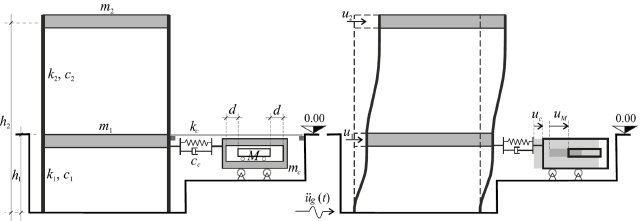Copyright © A.Di Egidio
UNIVERSITY OF L'AQUILA - ITALY
D.I.C.E.A.A. - Dipartimento di Ingegneria Civile, Edile-Architettura e Ambientale
Structural improve
Structural improvement
External struct.
The coupling of structures with tuned mass dampers, dynamic mass absorbers, elastoplastic dampers, and rigid walls is effective in
reducing displacements and drifts of frame structures under external loads. This paper analyses the effectiveness of connecting the
first storey of a frame structure to an external structure shorter than the frame structure by a visco-elastic device. Two alternative
visco-elastic devices are considered for the coupling, they are modelled with the Kelvin–Voigt and Maxwell constitutive laws, respectively.
Additionally, an inerter device is applied to the external structure to modify its inertial force and increase the effectiveness of
the coupling. The coupled structure is modelled as a three-degree-of-freedom mechanical system, and its equations of motion are obtained
by a direct approach. The coupling with the external structure is considered beneficial for the frame structure if the absolute displacements
of the coupling level or the inter-storey drifts reduce compared to those of the stand-alone frame structure. A preliminary modal
analysis shows that the coupling with the external structure equipped with the inerter device improves the dynamic and seismic performances
of the system. A further analysis is performed by considering four ground motion records. The results, organized in maps, confirm
that the coupling with the external structure reduces the displacements and drifts of the frame structure in large ranges of values
of the parameters that characterize the external structure and connection devicein terms of behavior charts, and post-critical dynamics
is studied in the space of bifurcation parameters.


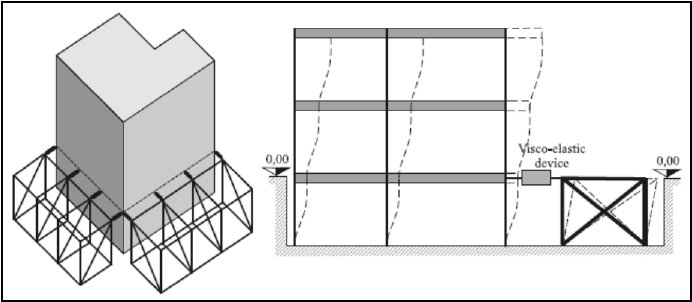
Fig. 10.8: External structure

The coupling with external mechanical systems such as oscillating masses working as tuned mass dampers, dynamic mass absorbers, elasto-plastic
dampers, and rigid walls is an effective method to reduce displacements and drifts of structures under external loads. An alternative
method is provided by the coupling of the structure with an independent, auxiliary elasto-plastic system. This paper investigates
the dynamic and seismic behaviour of a structure rigidly coupled with an auxiliary yielding mechanical system under harmonic and seismic
ground excitation. A two-degree-of-freedom model is used to describe the dynamic and seismic behaviour of the main structure rigidly
coupled o the yielding system, described by a one-degree-of-freedom model. The auxiliary system has an elasto-plastic constitutive
behaviour that is modelled by a Bouc-Wen model. The equations of motion of the coupled system are obtained by a direct approach. The
coupling with the yielding system is considered beneficial if the displacements of the coupled system reduce with respect to those
of the stand-alone frame structure. An extensive parametric analysis is performed to point out the role of the mechanical parameters
that describe the elasto-plastic constitutive behaviour of the auxiliary system. Results reveal that in large ranges of the parameters’
values the coupling with the elasto-plastic system improves the performance of the frame structure.


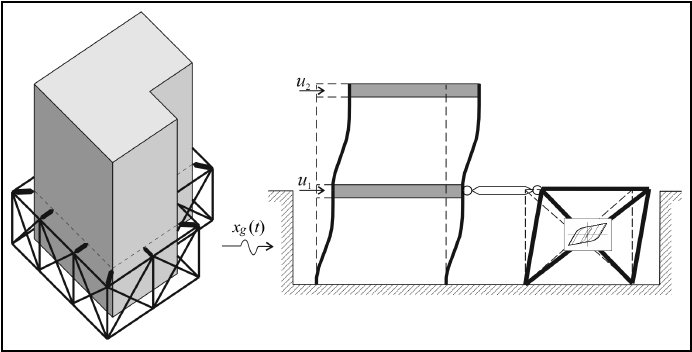
Fig. 10.9: Short exoskeleton


The coupling of frame structures with an external oscillating body such as a rigid wall, a dynamic mass absorbers, an elastoplastic
damper, or a tuned mass damper can be effective in reducing the displacements of the structure to be protected against seismic loads.
In this regard, this paper proposes connecting an external oscillating body to the first storey of a frame structure and studies the
effectiveness of the coupling by evaluating the reduction in the displacements of the frame structure. The inertial effects of the
oscillating body are increased by introducing a virtual mass, provided by an inerter device. The oscillating body, characterized by
physical and virtual masses, is connected to the frame structure through a hysteretic device. The study is performed on a dynamically
equivalent three-degree-of-freedom (3-DOF) model, whose equations are written by a direct approach. To verify the effectiveness of
the protection device, named Hysteretic Mass Damper Inerter (HMDI), in reducing the displacements of the frame structure, the displacement
of the first storey and the drifts of the upper storeys are compared to those of the frame structure not connected to the external
oscillating body. An initial spectral analysis, performed on the linearised mechanical system, clarifies the role of the parameters
of the external device in the dynamic behaviour of the coupled system. An additional seismic analysis is performed by using three
single earthquake records first, and then a set of seven additional earthquake records selected to be compatible with the design spectrum
of Los Angeles. Specific spectral gain maps are used to organize the results of an extensive parametric analysis. They show that the
HMDI reduces both displacements and drifts of the structure in large ranges of the parameters that characterize the HMDI.


Fig. 10.10: Frame coupled with the HMDI
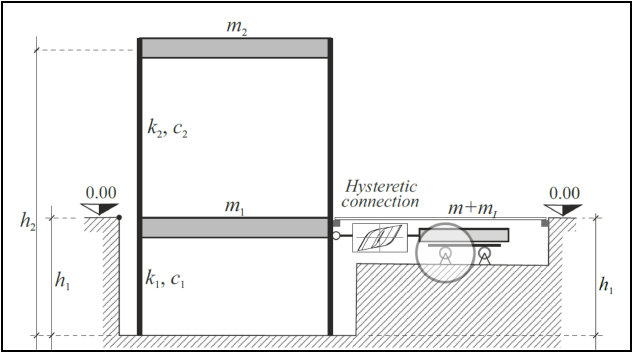


In this paper, a promising approach is studied that can efficiently mitigate seismic effects on a frame structure by coupling it with
an protection system. Various devices are employed to achieve this objective, including tuned mass dampers, dynamic mass absorbers,
elastoplastic dampers, and rocking rigid walls. This paper delves into the efficacy of a vibro-impacting nonlinear energy sink in
reducing seismic effects on a frame structure. More precisely, a supplementary apparatus, consisting of an auxiliary structure equipped
with a vibro-impacting nonlinear energy sink, is rigidly linked to the first story of the targeted frame structure. The seismic response
of this coupled system is derived through a dynamically equivalent, low-dimensional model. As a result of the rigid connection between
the frame structure and the protection system, the low-dimensional model includes only three degrees of freedom: two displacements
that represent the motion of the frame structure, which is rigidly connected to the external structure, while the third characterizes
the motion of the vibro-impacting mass. For the vibro-impacting nonlinear energy sink, an ideal model, which assumes instantaneous
impacts, is used for the vibro-impacting mass. The proposed model is used for an in-depth parametric analysis, and the outcomes are
presented in gain maps that illustrate the effectiveness of the coupling within a designated parameter plane. The findings demonstrate
that the coupling with the external structure, which is equipped with a vibro-impacting mass, effectively mitigates displacements
and drifts in the frame structure across a broad range of parameter values that define the protection system.


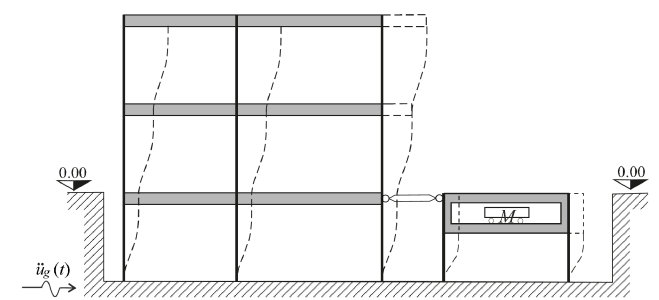
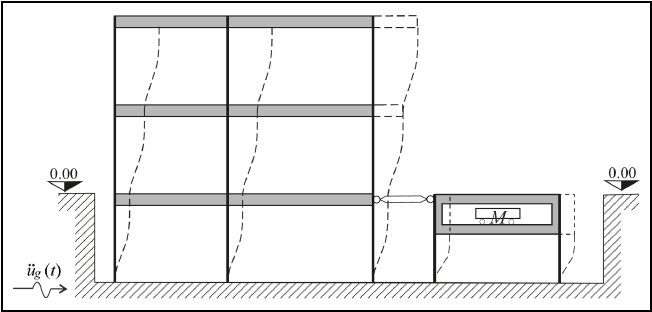
Fig. 10.11: Frame coupled with an external structure equipped with a VI-NES

It is well established that, for tuned mass dampers, a high mass ratio relative to the protected structure is essential for effective
performance under seismic excitation in most scenarios. This paper proposes a novel method to enhance the seismic effectiveness of
a tuned mass damper without increasing the mass ratio. The proposed approach introduces an innovative device in which a tuned mass
damper is serially coupled with a vibro-impacting mass that slides with negligible friction before impacting the boundaries of its
runway. This system is then connected to the first storey of the frame structure via a Kelvin–Voigt visco-elastic device. The study
employs a dynamically equivalent four-degree-of-freedom model, with its governing equations derived through a direct formulation approach.
Initially, the coupled system is subjected to harmonic excitation, and the resulting behaviour is represented using frequency–response
curves, which depict the maximum displacements of the structure in relation to the excitation frequency. Following this, a subsequent
analysis involves subjecting the system to three distinct earthquake records to evaluate its performance under seismic excitation.
To evaluate the effectiveness of the proposed protective device in reducing the displacements of the frame structure during seismic
events, the displacements of the first storey and the drifts of the superstructure are compared to those of a frame structure without
the external device. The findings indicate that the proposed device performs effectively across a wide range of system parameters,
proving to be especially effective for low- and medium-rise frame structures.



Fig. 10.12: Frame coupled with an external TMD equipped with a VI-NES
































